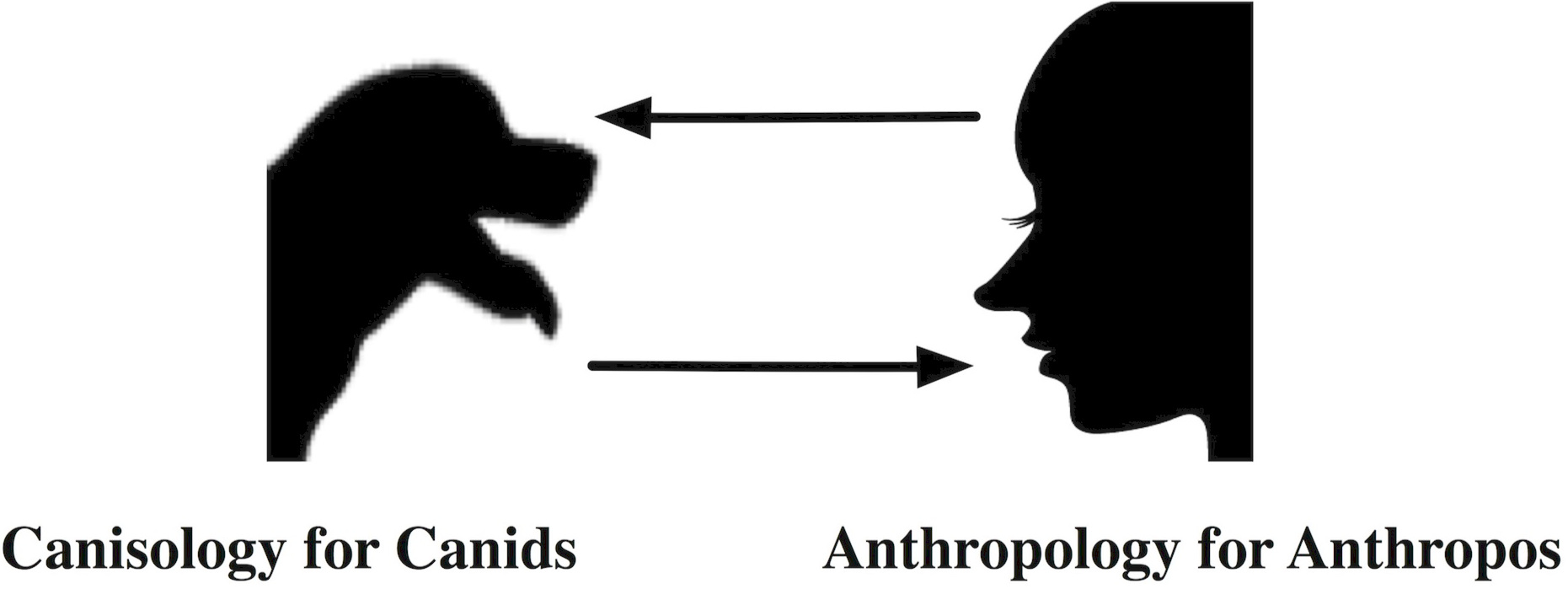
狗類学
Canisology, KOH-RUI GAKU

犬 (類)による、犬のための、犬自身による研究を狗類学(こうるいがく: canisology)という。
Canisology is a neologism coined by cultural anthropologist Mitzub'ixi Quq Ch'ij and his collegues, their edited book "INU KARAMITA JINRUI-SHI (Human History from dog's perspective: An Intriduction to Canisology)" (2019).
こ の一連の学知は、我々の「生物種」的立場である人間の立場から動物を研究対象とするアプローチより出発す る。このような研究態度は「犬の人類学」の立 場とも言えるものである――人間が中心で犬は観想の対象である。これに鋭く対立する立場が、Eduardo Kohn, How Forests Think: Toward an Anthropology Beyond the Human, 2013である。エクアドル上流のルナの人々の民族誌記述を試みたE・コーンは、人間を他の生命形態に対して特権的に描くことに反対し、代替的記法に挑戦 する。これは、ボルネオの狩猟採集民プナンを描く奥野克巳の立場に似て、挑戦的な近年の多自然主義(multi-naturalism) と軌を一にするものである。その対立概念ないしは意味の矛盾項は「犬の人類学」の多文化主義だ。
★犬リンク集
︎▶私たちはイヌではなく、犬様なのだ!︎▶︎︎犬について知ろう(このページと同じWikiからの翻訳)▶狗類学リンク集︎▶︎︎▶︎▶︎︎▶︎▶︎︎▶︎▶︎
| The
dog (Canis familiaris or Canis lupus familiaris) is a domesticated
descendant of the wolf. Also called the domestic dog, it is derived
from extinct gray wolves, and the gray wolf is the dog's closest living
relative. The dog was the first species to be domesticated by humans.
Experts estimate that hunter-gatherers domesticated dogs more than
15,000 years ago, which was before the development of agriculture. Due
to their long association with humans, dogs have expanded to a large
number of domestic individuals and gained the ability to thrive on a
starch-rich diet that would be inadequate for other canids.[4] The dog has been selectively bred over millennia for various behaviors, sensory capabilities, and physical attributes.[5] Dog breeds vary widely in shape, size, and color. They perform many roles for humans, such as hunting, herding, pulling loads, protection, assisting police and the military, companionship, therapy, and aiding disabled people. Over the millennia, dogs became uniquely adapted to human behavior, and the human–canine bond has been a topic of frequent study. This influence on human society has given them the sobriquet of "man's best friend". |
イヌ(Canis
familiarisまたはCanis lupus
familiaris)はオオカミの家畜化された子孫である。家畜犬とも呼ばれるイヌは、絶滅したハイイロオオカミの子孫であり、ハイイロオオカミはイヌ
の最も近い親戚である。犬は人類によって家畜化された最初の種である。専門家の推定によれば、狩猟採集民が犬を家畜化したのは15,000年以上前であ
り、農耕が発達する以前のことである。人間との長い付き合いにより、イヌは多くの家畜個体へと拡大し、他のイヌ科動物には不十分なデンプンを多く含む食事
で成長する能力を獲得した[4]。 犬は様々な行動、感覚能力、身体的属性のために数千年にわたって選択的に繁殖されてきた。狩猟、牧畜、荷物の運搬、保護、警察や軍隊の補助、同伴、セラ ピー、障害者の補助など、犬は人間のために多くの役割を果たしている。何千年もの間、犬は人間の行動に独自に適応するようになり、人間と犬の絆は頻繁に研 究されてきた。このような人間社会への影響から、犬は「人間の最良の友」という俗称を持つようになった。 |
| Taxonomy Further information: Canis lupus dingo § Taxonomic debate – the domestic dog, dingo, and New Guinea singing dog In 1758, the Swedish botanist and zoologist Carl Linnaeus published in his Systema Naturae, the two-word naming of species (binomial nomenclature). Canis is the Latin word meaning "dog",[6] and under this genus, he listed the domestic dog, the wolf, and the golden jackal. He classified the domestic dog as Canis familiaris and, on the next page, classified the grey wolf as Canis lupus.[2] Linnaeus considered the dog to be a separate species from the wolf because of its upturning tail (cauda recurvata in Latin term), which is not found in any other canid.[7] In 1999, a study of mitochondrial DNA (mtDNA) indicated that the domestic dog may have originated from the grey wolf, with the dingo and New Guinea singing dog breeds having developed at a time when human communities were more isolated from each other.[8] In the third edition of Mammal Species of the World published in 2005, the mammalogist W. Christopher Wozencraft listed under the wolf Canis lupus its wild subspecies and proposed two additional subspecies, which formed the domestic dog clade: familiaris, as named by Linnaeus in 1758 and, dingo named by Meyer in 1793. Wozencraft included hallstromi (the New Guinea singing dog) as another name (junior synonym) for the dingo. Wozencraft referred to the mtDNA study as one of the guides informing his decision.[3] Mammalogists have noted the inclusion of familiaris and dingo together under the "domestic dog" clade[9] with some debating it.[10] In 2019, a workshop hosted by the IUCN/Species Survival Commission's Canid Specialist Group considered the dingo and the New Guinea singing dog to be feral Canis familiaris and therefore did not assess them for the IUCN Red List of Threatened Species.[11] |
分類学 さらなる情報 Canis lupus dingo § 分類学上の論争 - 飼い犬、ディンゴ、ニューギニア・シンギング・ドッグ 1758年、スウェーデンの植物学者であり動物学者でもあるカール・リンネが『自然科学体系(Systema Naturae)』の中で、2単語による種の命名法(2命名法)を発表した。カニス(Canis)はラテン語で「犬」を意味し[6]、この属の下に家畜 犬、オオカミ、ゴールデンジャッカルを挙げた。リンネは、他のイヌ科動物には見られない上向きの尾(ラテン語でcauda recurvata)を持つことから、イヌをオオカミとは別の種と考えた[7]。 1999年、ミトコンドリアDNA(mtDNA)の研究により、家庭犬はハイイロオオカミから発生した可能性があり、ディンゴとニューギニア・シンギン グ・ドッグの犬種は、人類社会が互いに孤立していた時代に発達したことが示された。 [8]2005年に出版された『Mammal Species of the World(世界の哺乳類種)』の第3版では、哺乳類学者のW.クリストファー・ウォゼンクラフトがオオカミCanis lupusの野生亜種をリストアップし、1758年にリンネによって命名されたfamiliarisと1793年にマイヤーによって命名されたdingo という2つの亜種を追加提案し、家庭犬クレードを形成した。ウォーゼンクラフトはディンゴの別名(ジュニア・シノニム)としてホールストロミ(ニューギニ ア・シンギング・ドッグ)を含めた。ウォーゼンクラフトはmtDNAの研究を、彼の決定に情報を与えた指針の一つとして言及した[3]。哺乳類学者は、 ファムファミリスとディンゴが「家畜犬」クレードの下に一緒に含まれることを指摘しており[9]、それについて議論する者もいる[10]。 2019年、国際自然保護連合(IUCN)/種の保存委員会のイヌ科専門家グループが主催したワークショップでは、ディンゴとニューギニア・シンギング・ ドッグは野生のイヌ科の犬であるとみなされたため、絶滅危惧種のIUCNレッドリストへの評価は行われなかった[11]。 |
| Evolution Main article: Evolution of the wolf 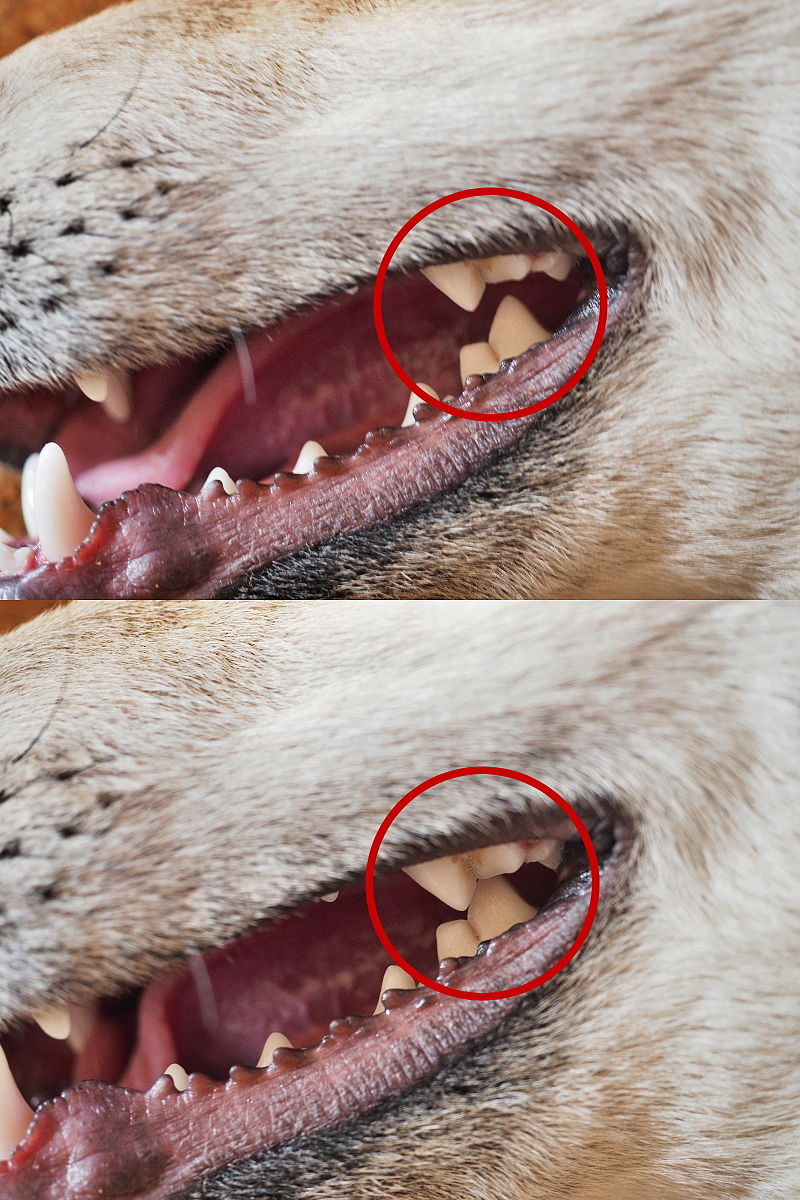 Location of a dog's carnassials; the inside of the 4th upper premolar aligns with the outside of the 1st lower molar, working like scissor blades. Domestication Main article: Domestication of the dog The earliest remains generally accepted to be those of a domesticated dog were discovered in Bonn-Oberkassel, Germany. Contextual, isotopic, genetic, and morphological evidence shows that this dog was not a local wolf.[12] The dog was dated to 14,223 years ago and was found buried along with a man and a woman, all three having been sprayed with red hematite powder and buried under large, thick basalt blocks. The dog had died of canine distemper.[13] Earlier remains dating back to 30,000 years ago have been described as Paleolithic dogs, but their status as dogs or wolves remains debated[14] because considerable morphological diversity existed among wolves during the Late Pleistocene.[1] This timing indicates that the dog was the first species to be domesticated[15][16] in the time of hunter-gatherers,[17] which predates agriculture.[1] DNA sequences show that all ancient and modern dogs share a common ancestry and descended from an ancient, extinct wolf population which was distinct from the modern wolf lineage.[18][17] The dog is a classic example of a domestic animal that likely travelled a commensal pathway into domestication.[14][19] The questions of when and where dogs were first domesticated have taxed geneticists and archaeologists for decades.[15] Genetic studies suggest a domestication process commencing over 25,000 years ago, in one or several wolf populations in either Europe, the high Arctic, or eastern Asia.[20] In 2021, a literature review of the current evidence infers that the dog was domesticated in Siberia 23,000 years ago by ancient North Siberians, then later dispersed eastward into the Americas and westward across Eurasia,[12] with dogs likely accompanying the first humans to inhabit the Americas.[12] Breeds Main article: Dog breed Further information: Dog type Dogs are the most variable mammal on earth, with around 450 globally recognized dog breeds.[20][21] In the Victorian era, directed human selection developed the modern dog breeds, which resulted in a vast range of phenotypes.[16] Most breeds were derived from small numbers of founders within the last 200 years.[16][20] Since then, dogs have undergone rapid phenotypic change and have been subjected to artificial selection by humans. The skull, body, and limb proportions between breeds display more phenotypic diversity than can be found within the entire order of carnivores. These breeds possess distinct traits related to morphology, which include body size, skull shape, tail phenotype, fur type and colour.[16] Their behavioural traits include guarding, herding, hunting,[16] retrieving, and scent detection. Their personality traits include hypersocial behavior, boldness, and aggression.[16] Present-day dogs are dispersed around the world.[20] An example of this dispersal is the numerous modern breeds of European lineage during the Victorian era.[17] 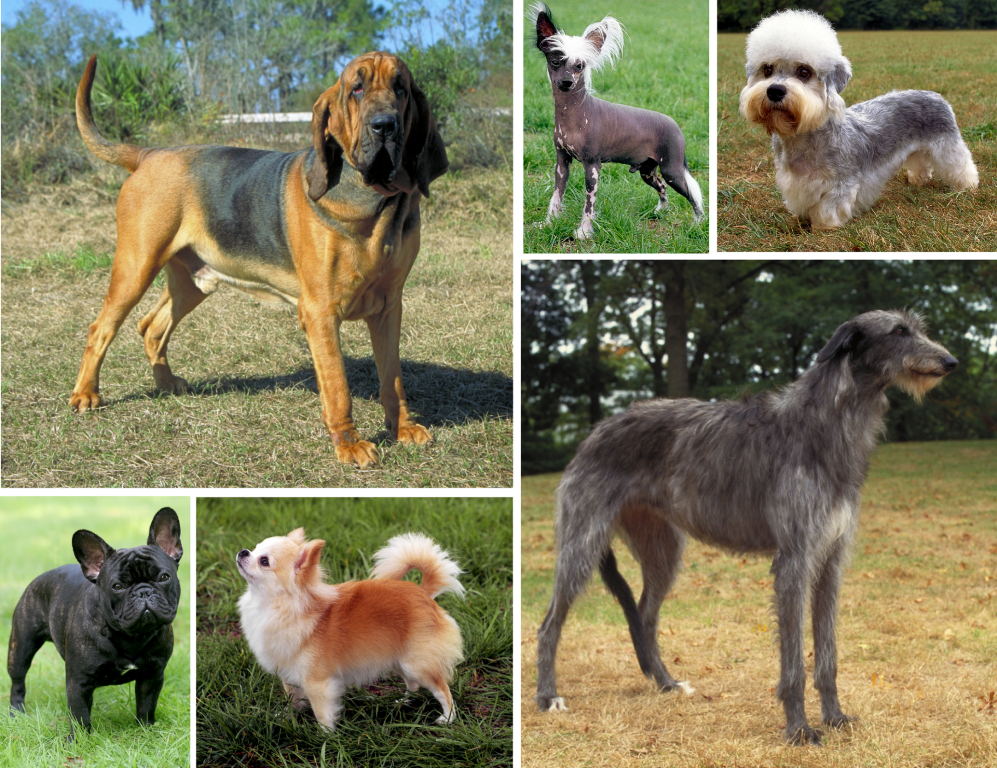 Morphological variation in six dogs 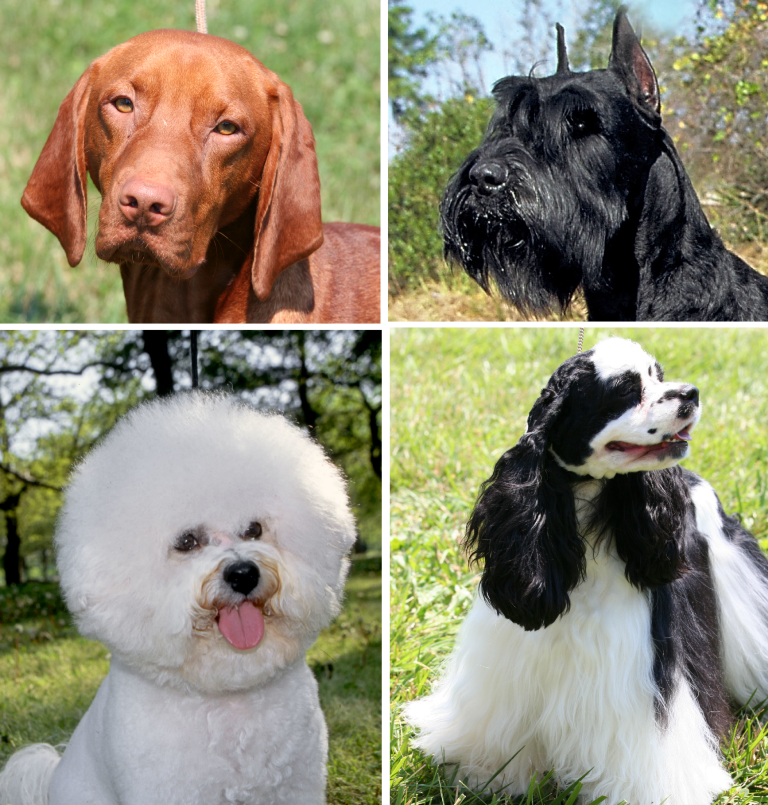 Phenotypic variation in four dogs |
進化 主な記事 オオカミの進化  犬の犬歯の位置。第4上顎小臼歯の内側と第1下顎大臼歯の外側が一致し、ハサミの刃のようになっている。 家畜化 主な記事 犬の家畜化 一般に家畜化された犬のものと考えられている最古の遺骨は、ドイツのボン・オーバーカッセルで発見された。この犬の年代は14,223年前と推定され、男 性と女性とともに埋葬されているのが発見されたが、3頭とも赤いヘマタイトの粉末をかけられ、大きくて厚い玄武岩の下に埋められていた。犬は犬ジステン パーで死亡していた[13]。30,000年前にさかのぼるそれ以前の遺体は旧石器時代の犬とされているが、後期更新世にはオオカミの間にかなりの形態学 的多様性が存在していたため、犬かオオカミかについては議論が続いている[14]。 この時期は、イヌが狩猟採集民の時代に家畜化された最初の種であることを示している[15][16]。DNA配列は、すべての古代と現代のイヌが共通の祖 先を持ち、現代のオオカミの系統とは異なる古代の絶滅したオオカミの集団の子孫であることを示している[18][17]。 14][19]犬がいつ、どこで最初に家畜化されたかという疑問は、何十年もの間、遺伝学者や考古学者を悩ませてきた。遺伝学的研究は、家畜化プロセスが 25,000年以上前に、ヨーロッパ、高緯度北極圏、東アジアのいずれかのオオカミの個体群の中で始まったことを示唆している。 [2021年、現在の証拠の文献レビューは、犬は23,000年前にシベリアで古代の北シベリア人によって家畜化され、その後アメリカ大陸に東進し、ユー ラシア大陸を西進したと推測している[12]。 犬種 主な記事 犬種 さらに詳しい情報 犬の種類 犬は地球上で最も多様性のある哺乳類であり、世界的には約450の犬種が認められている[20][21]。ビクトリア朝時代には、人為的な淘汰によって現 代の犬種が開発され、その結果、膨大な種類の表現型が生まれた。犬種間の頭蓋骨、胴体、四肢のプロポーションは、肉食動物全体の中で見られるよりも表現型 の多様性を示している。これらの犬種は、体の大きさ、頭がい骨の形、尾の表現型、毛皮の種類や色など、形態学に関連する明確な形質を持っている[16]。 その行動特性には、番犬、群れ飼い、狩猟、[16]回収、匂い探知などが含まれる。現在の犬は世界中に分散している[20]。この分散の一例として、ヴィ クトリア朝時代のヨーロッパ血統の多数の近代犬種が挙げられる[17]。  6頭の犬の形態学的変異  4頭の犬の表現型変異 |
| Anatomy Main article: Dog anatomy Skeleton 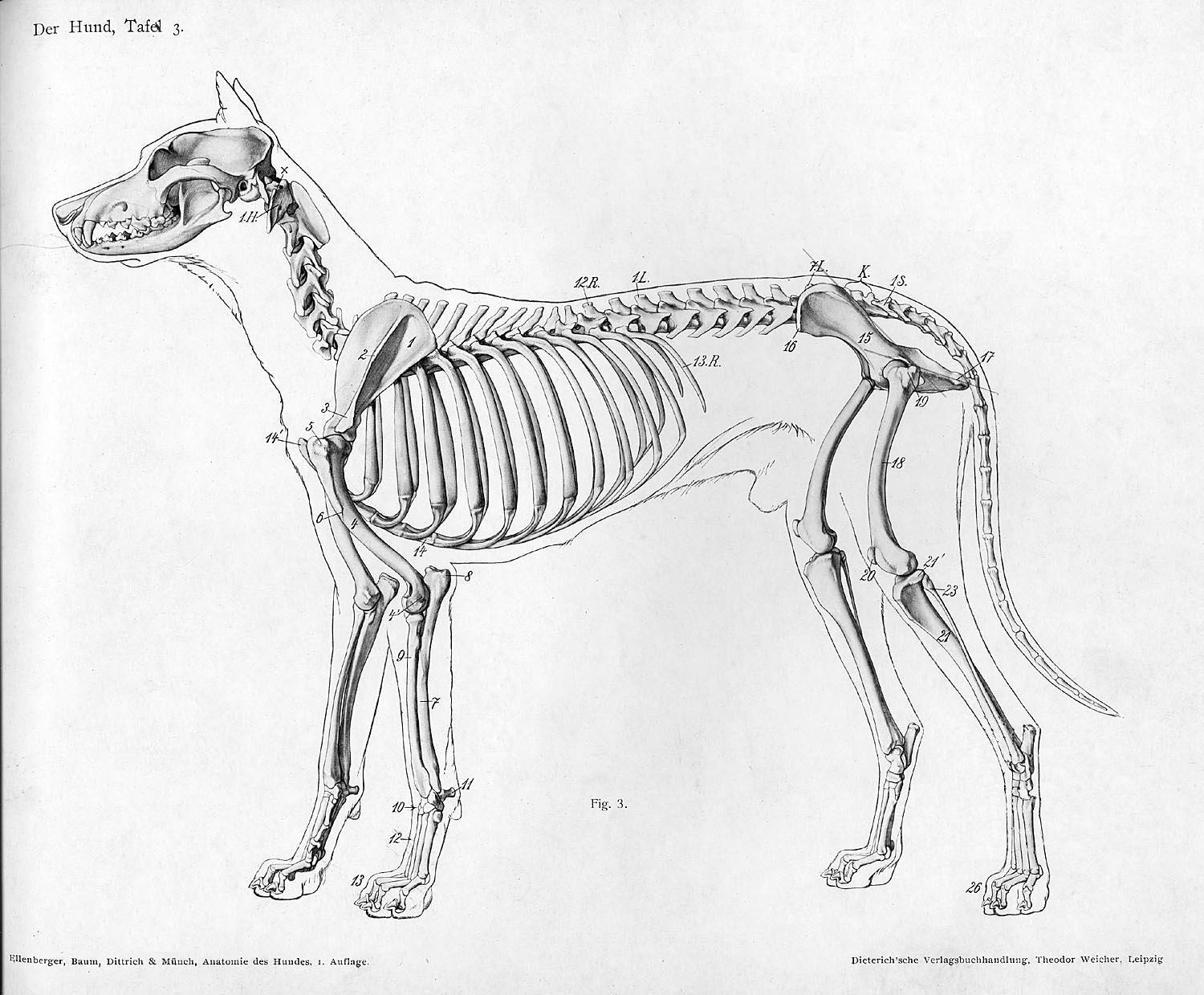 A lateral view of a dog skeleton All healthy dogs, regardless of their size and type, have an identical skeletal structure with the exception of the number of bones in the tail, although there is significant skeletal variation between dogs of different types.[22][23] The dog's skeleton is well adapted for running; the vertebrae on the neck and back have extensions for back muscles, consisting of epaxial muscles and hypaxial muscles, to connect to; the long ribs provide room for the heart and lungs; and the shoulders are unattached to the skeleton, allowing for flexibility.[22][23][24] Compared to the dog's wolf-like ancestors, selective breeding since domestication has seen the dog's skeleton larger in size for larger types such as mastiffs and miniaturised for smaller types such as terriers; dwarfism has been selectively used for some types where short legs are advantageous, such as dachshunds and corgis.[23] Most dogs naturally have 26 vertebrae in their tails, but some with naturally short tails have as few as three.[22] The dog's skull has identical components regardless of breed type, but there is significant divergence in terms of skull shape between types.[23][25] The three basic skull shapes are the elongated dolichocephalic type as seen in sighthounds, the intermediate mesocephalic or mesaticephalic type, and the very short and broad brachycephalic type exemplified by mastiff type skulls.[23][25] Senses Further information: Dog anatomy § Senses Dogs' senses include vision, hearing, smell, taste, touch, and magnetoreception. One study suggests that dogs can feel small variations in Earth's magnetic field.[26] Dogs prefer to defecate with their spines aligned in a north-south position in calm magnetic field conditions.[27] Dogs' vision is dichromatic; the dog's visual world consists of yellows, blues, and grays. They have difficulty differentiating between red and green. The divergence of the eye axis of dogs ranges from 12–25°, depending on the breed. Dogs' eyes of different breeds can have different retina configurations. The fovea centralis area of dogs' eyes, which is attached to a nerve fiber, is the most sensitive to photons.[28] Coat Main article: Dog coat The coats of domestic dogs are of two varieties: "double" being familiar with dogs (as well as wolves) originating from colder climates, made up of a coarse guard hair and a soft down hair, or "single", with the topcoat only. Breeds may have an occasional "blaze", stripe, or "star" of white fur on their chest or underside.[29] Premature graying can occur in dogs as early as one year of age; this is associated with impulsive behaviors, anxiety behaviors, and fear of unfamiliar noise, people, or animals.[30] Dewclaw A dog's dewclaw is the five digits in the dog's forelimb and hind legs. Dogs' forelimbs' dewclaws are attached by bone and ligament, while the dogs' hind legs' are attached by skin to the limb. Most dogs aren't born with dewclaws in their hind legs, and some are without them in their forelimbs. Dogs' dewclaws consist of the proximal phalanxes and distal phalanxes. Some publications thought that dewclaws in wolves, who usually do not have dewclaws, were a sign of hybridization with dogs.[31][32] Tail A dog's tail is the terminal appendage of the vertebral column, which is made up of a string of 5 to 23 vertebrae enclosed in muscles and skin that support the dog's back extensor muscles. One of the primary functions of a dog's tail is to communicate their emotional state.[33] The tail also helps the dog maintain balance by putting its weight on the opposite side of the dog's tilt, and it can also help the dog spread its anal gland's scent through the tail's position and movement.[34] Dogs can have a violet gland (or supracaudal gland) characterized by sebaceous glands on the dorsal surface of their tails; in some breeds, it may be vestigial or absent. The enlargement of the violet gland in the tail, which can create a bald spot from hair loss, can be caused by Cushing's disease or an excess of sebum from androgens in the sebaceous glands.[35] A study suggests that dogs show asymmetric tail-wagging responses to different emotive stimuli. "Stimuli that could be expected to elicit approach tendencies seem to be associated with [a] higher amplitude of tail-wagging movements to the right side".[36][37] Dogs can injure themselves by wagging their tails forcefully; this condition is called kennel tail, happy tail, bleeding tail, or splitting tail.[38] In some hunting dogs, the tail is traditionally docked to avoid injuries. Some dogs can be born without tails because of a DNA variant in the T gene, which can also result in a congenitally short (bobtail) tail.[39] 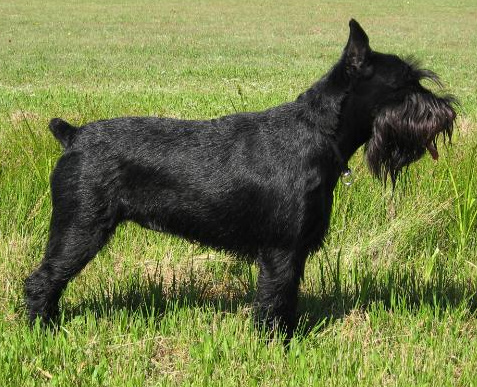 A black Standard Schnauzer with a docked tail |
解剖学 主な記事 犬の解剖学 骨格  犬の骨格の側面図 健康な犬は、その大きさや種類に関係なく、尾の骨の数を除いてすべて同じ骨格構造を持っているが、異なる種類の犬の間では骨格に大きな違いがある。 [22][23]犬の骨格は走ることによく適応している。首と背中の椎骨には、軸上筋と軸下筋からなる背筋が接続するための延長部があり、長い肋骨は心臓 と肺のためのスペースを提供し、肩は骨格に取り付けられていないため柔軟性がある[22][23][24]。 犬のオオカミのような祖先と比較すると、家畜化されて以来、選択的な繁殖により、犬の骨格はマスティフのような大きなタイプではより大きく、テリアのような小さなタイプではより小さくなっている。 犬の頭蓋骨は犬種に関係なく同一の構成要素を持っているが、頭蓋骨の形状に関しては犬種間で大きな相違がある[23][25]。3つの基本的な頭蓋骨の形 状は、サイトハウンドに見られるような細長いドリコセファリック型、中間のメソセファリック型またはメサティセファリック型、そしてマスチフ型の頭蓋骨に 代表される非常に短く広いブラキセファリック型である[23][25]。 感覚 さらなる情報 犬の解剖学§感覚 犬の感覚には、視覚、聴覚、嗅覚、味覚、触覚、磁気受容などがある。ある研究によると、犬は地球の磁場のわずかな変化を感じることができるそうだ[26]。 犬の視覚は二色性で、黄色、青色、灰色で構成されている。赤と緑を区別するのは難しい。犬の眼軸の乖離は12~25°で、犬種によって異なる。犬種によって網膜の形状は異なる。犬の目の中心窩は神経線維に付着しており、光子に対して最も敏感である[28]。 被毛 主な記事 犬の被毛 家庭犬の被毛には2種類ある: 「ダブル」は寒冷地原産の犬(オオカミも同様)によく見られ、粗い番毛と柔らかい下毛で構成されている。犬種によっては、胸や下側に白い毛の「ブレー ズ」、縞模様、または「スター」を持つことがある[29]。早期の白髪化は、早ければ1歳の犬で起こることがある。これは、衝動的な行動、不安行動、およ び見慣れない音、人、動物に対する恐怖と関連している[30]。 露爪 犬の露爪とは、犬の前肢と後肢にある5本の指のことである。犬の前肢の露爪は骨と靭帯によって取り付けられ、犬の後肢の露爪は皮膚によって四肢に取り付け られている。ほとんどの犬の後肢には生まれつき露爪がなく、前肢にはない犬もいる。犬の露爪は近位指節と遠位指節からなる。一部の出版物では、通常露爪を 持たないオオカミに露爪があるのは、犬との交雑の兆候であると考えられていた[31][32]。 尾 犬の尾は椎骨の末端付属器官であり、筋肉と皮膚に包まれた5~23個の椎骨のひもで構成され、犬の背部伸筋を支えている。犬の尾の主な機能の1つは、犬の 感情状態を伝えることである[33]。尾はまた、犬の傾きと反対側に体重をかけることでバランスを保つのを助け、尾の位置と動きによって犬が肛門腺の匂い を広めるのを助けることもある[34]。犬は尾の背面に皮脂腺を特徴とするすみれ腺(または尾上腺)を持つことがあるが、犬種によっては、すみれ腺は退化 しているか、ないこともある。尾のすみれ腺の肥大は、脱毛による禿頭を作ることがあるが、これはクッシング病または皮脂腺のアンドロゲンによる皮脂の過剰 が原因である[35]。 ある研究では、犬はさまざまな情動刺激に対して非対称な尾振り反応を示すことが示唆されている。「接近傾向を誘発すると予想される刺激は、右側への尾を振る動きの振幅が大きいことと関連しているようである」[36][37]。 犬は尻尾を力強く振ることで怪我をすることがあり、この状態はケンネルテール、ハッピーテール、ブリーディングテール、スプリッティングテールと呼ばれる [38]。T遺伝子のDNA変異により、生まれつき尻尾がない犬もおり、先天的に尻尾が短い(ボブテイル)犬もいる[39]。  尾がドッキングされた黒のスタンダード・シュナウザー |
| Health Main article: Dog health Some breeds of dogs are prone to specific genetic ailments such as elbow and hip dysplasia, blindness, deafness, pulmonic stenosis, a cleft palate, and trick knees. Two severe medical conditions significantly affecting dogs are pyometra, affecting unspayed females of all breeds and ages, and gastric dilatation volvulus (bloat), which affects larger breeds or deep-chested dogs. Both of these are acute conditions and can kill rapidly. Dogs are also susceptible to parasites such as fleas, ticks, mites, hookworms, tapeworms, roundworms, and heartworms that can live in their hearts.[40] Several human foods and household ingestibles are toxic to dogs, including chocolate solids, causing theobromine poisoning, onions and garlic, causing thiosulfate, sulfoxide or disulfide poisoning, grapes and raisins, macadamia nuts, and xylitol.[41] The nicotine in tobacco can also be dangerous to dogs. Signs of ingestion can include copious vomiting (e.g., from eating cigar butts) or diarrhea. The symptoms of hydrocarbon mixture indigestion can be abdominal pain, aspiration pneumonia, oral ulcers, vomiting, or death.[42][43] The most common deaths among dogs were neoplasia and heart disease, followed by toxicosis and gastrointestinal disease.[44][45][46] A 20-year-record study found that respiratory disease was the most common cause of death in Bulldogs.[47] Puppies were more likely to die from infection or congenital disease.[48] Dogs can also have some of the same health conditions as humans, including diabetes, dental and heart disease, epilepsy, cancer, hypothyroidism, and arthritis. Type 1 diabetes mellitus, resembling human diabetes, is the type of diabetes seen most often in dogs.[49] Their pathology is similar to that of humans, as is their response to treatment and their outcomes. The genes involved in canine obsessive-compulsive disorders led to the detection of four genes in humans' related pathways.[20] Lifespan Further information: Aging in dogs The typical lifespan of dogs varies widely among breeds, but the median longevity (the age at which half the dogs in a population have died and half are still alive) is approximately 12.7 years.[50][51] Obesity correlates negatively with longevity with one study finding obese dogs have a life expectancy approximately a year and a half less than dogs with a healthy weight.[50] Reproduction Main article: Canine reproduction  Two dogs tied after mating In domestic dogs, sexual maturity happens around six months to one year for both males and females, although this can be delayed until up to two years of age for some large breeds. This is the time at which female dogs will have their first estrous cycle, characterized by their vulvas swelling and producing discharges, usually lasting between 4 and 20 days.[52] They will experience subsequent estrous cycles semiannually, during which the body prepares for pregnancy. At the peak of the cycle, females will become estrous, mentally and physically receptive to copulation. Because the ova survive and can be fertilized for a week after ovulation, more than one male can sire the same litter.[5] Fertilization typically occurs two to five days after ovulation. After ejaculation, the dogs are coitally tied for around 5–30 minutes because of the male's bulbus glandis swelling and the female's constrictor vestibuli contracting; the male will continue ejaculating until they untie naturally.[53][54] 14–16 days after ovulation, the embryo attaches to the uterus, and after seven to eight more days, a heartbeat is detectable.[55][56] Dogs bear their litters roughly 58 to 68 days after fertilization,[5][57] with an average of 63 days, although the length of gestation can vary. An average litter consists of about six puppies.[58] Neutering Neutering is the sterilization of animals, usually by removing the male's testicles or the female's ovaries and uterus, to eliminate the ability to procreate and reduce sex drive. Because of dogs' overpopulation in some countries, many animal control agencies, such as the American Society for the Prevention of Cruelty to Animals (ASPCA), advise that dogs not intended for further breeding should be neutered, so that they do not have undesired puppies that may later be euthanized.[59] According to the Humane Society of the United States, three to four million dogs and cats are euthanized each year.[60] Many more are confined to cages in shelters. Spaying or castrating dogs is considered a major factor in keeping overpopulation down.[61] Neutering reduces problems caused by hypersexuality, especially in male dogs.[62] Spayed female dogs are less likely to develop cancers affecting the mammary glands, ovaries, and other reproductive organs.[63] However, neutering increases the risk of urinary incontinence in female dogs,[64] prostate cancer in males,[65] and osteosarcoma, hemangiosarcoma, cruciate ligament rupture, pyometra, obesity, and diabetes mellitus in either sex.[66] Inbreeding depression A common breeding practice for pet dogs is to mate them between close relatives (e.g., between half- and full-siblings).[67] Inbreeding depression is considered to be due mainly to the expression of homozygous deleterious recessive mutations.[68] Outcrossing between unrelated individuals, including dogs of different breeds, results in the beneficial masking of deleterious recessive mutations in progeny.[69] In a study of seven dog breeds (the Bernese Mountain Dog, Basset Hound, Cairn Terrier, Brittany, German Shepherd Dog, Leonberger, and West Highland White Terrier), it was found that inbreeding decreases litter size and survival.[70] Another analysis of data on 42,855 Dachshund litters found that as the inbreeding coefficient increased, litter size decreased and the percentage of stillborn puppies increased, thus indicating inbreeding depression.[71] In a study of Boxer litters, 22% of puppies died before reaching 7 weeks of age. Stillbirth was the most frequent cause of death, followed by infection. Mortality due to infection increased significantly with increases in inbreeding.[72] |
健康 主な記事 犬の健康 犬種によっては、肘や股関節の形成不全、失明、難聴、肺気管支狭窄、口蓋裂、トリック・ニーズなど、特定の遺伝的疾患にかかりやすい。犬に重大な影響を及 ぼす2つの重篤な病状は、すべての犬種と年齢の未去勢の雌に影響を及ぼす子宮蓄膿症と、大型犬種や胸が深い犬に影響を及ぼす胃拡張捻挫(鼓腸症)である。 いずれも急性の疾患で、急速に死に至ることもある。犬はまた、ノミ、ダニ、鉤虫、条虫、回虫、心臓に寄生する心虫などの寄生虫に感染しやすい[40]。 テオブロミン中毒を引き起こす固形チョコレート、チオ硫酸塩中毒、スルホキシド中毒、ジスルフィド中毒を引き起こすタマネギとニンニク、ブドウとレーズ ン、マカデミアナッツ、キシリトールなど、いくつかの人間の食品や家庭用摂取物は犬にとって毒性がある。摂取の兆候としては、大量の嘔吐(葉巻の吸殻を食 べた場合など)や下痢がある。炭化水素混合物の消化不良の症状としては、腹痛、誤嚥性肺炎、口腔潰瘍、嘔吐、または死亡がある[42][43]。 犬の死亡で最も多いのは新生物および心臓病で、次いで中毒症および胃腸病であった。 [20年間の記録から、呼吸器疾患がブルドッグの最も一般的な死因であることが判明している[47]。 子犬は感染症や先天性疾患で死亡する可能性が高い[48]。 犬も糖尿病、歯科疾患、心臓疾患、てんかん、癌、甲状腺機能低下症、関節炎など、人間と同じ健康状態になることがある。ヒトの糖尿病に似た1型糖尿病は、 犬で最も多く見られる糖尿病のタイプである[49]。その病態はヒトのそれと類似しており、治療に対する反応や転帰も同様である。イヌの強迫性障害に関与 する遺伝子から、ヒトの関連経路にある4つの遺伝子が検出された[20]。 寿命 さらなる情報 犬の老化 犬の典型的な寿命は犬種によって大きく異なるが、寿命の中央値(ある集団の犬の半数が死亡し、半数がまだ生存している年齢)は約12.7年である[50] [51]。肥満は寿命と負の相関があり、ある研究では肥満の犬は健康的な体重の犬よりも寿命が約1年半短いという結果が出ている[50]。 繁殖 主な記事 犬の繁殖  交配後に結ばれた2頭の犬 家畜犬の場合、性成熟はオス・メスともに6カ月から1年前後で起こるが、大型犬では2歳まで遅れることもある。この時期にメス犬は最初の発情周期を迎え、 膣口が腫れて分泌物が出るのが特徴で、通常は4~20日間続く[52]。周期のピークになると、メスは発情し、精神的にも肉体的にも交尾を受け入れるよう になる。卵子は排卵後1週間は生存し、受精することができるため、複数の雄が同じ子を産むことができる[5]。受精は通常、排卵の2~5日後に起こる。射 精後、雄の球腺が膨張し、雌の前庭収縮器が収縮するため、犬は5~30分ほど交尾をする;雄は自然にほどけるまで射精を続ける。 [53][54]排卵から14~16日後に胚が子宮に付着し、さらに7~8日後に心拍が検出できるようになる。[55][56]犬は受精からおよそ 58~68日後に子を産むが[5][57]、平均は63日であるが、妊娠期間は変動することがある。平均的な出産頭数は約6頭である[58]。 去勢手術 去勢手術は動物の不妊手術であり、通常はオスの睾丸またはメスの卵巣と子宮を摘出することによって、子孫を残す能力をなくし、性欲を減退させる。アメリカ 動物虐待防止協会(ASPCA)のような多くの動物管理機関は、犬の過剰繁殖のため、さらなる繁殖を目的としない犬には去勢手術を施し、望まない子犬を産 ませ、後に安楽死させることがないようにするよう勧告している。犬の不妊手術や去勢手術は、過剰繁殖を抑える大きな要因と考えられている[61]。 去勢手術は、特に雄犬の性欲亢進による問題を軽減する[62]。 避妊手術をした雌犬は、乳腺、卵巣、および他の生殖器に影響を及ぼす癌を発症する可能性が低い[63]。 しかし、去勢手術は雌犬の尿失禁[64]、雄の前立腺癌[65]、および雌雄いずれかの骨肉腫、血管肉腫、十字靭帯断裂、子宮蓄膿症、肥満、および糖尿病 のリスクを増加させる[66]。 近親交配によるうつ病 愛玩犬の一般的な繁殖方法は、近親者間(例えば、異母兄妹間)で交配させることである[67]。近親交配抑制は主にホモ接合性の劇症劣性突然変異の発現に よるものと考えられている[68]。異なる犬種の犬を含む血縁関係のない個体間で交配させると、子孫において劇症劣性突然変異が有益にマスキングされる [69]。 7犬種(バーニーズ・マウンテン・ドッグ、バセット・ハウンド、ケルン・テリア、ブリタニー、ジャーマン・シェパード・ドッグ、レオンベルガー、ウエス ト・ハイランド・ホワイト・テリア)の研究では、近親交配は出産頭数と生存率を減少させることが判明している。 [70]42,855頭のダックスフントの子犬のデータを分析したところ、近親交配係数が高くなるにつれて子犬のサイズが小さくなり、死産の割合が高くな ることがわかりました。死産が最も頻度の高い死因であり、次いで感染症であった。感染症による死亡率は近親交配の増加とともに有意に増加した[72]。 |
| Behavior Main article: Dog behavior See also: Dog behavior § Behavior compared with other canids Dog behavior is the internally coordinated responses (actions or inactions) of the domestic dog (individuals or groups) to internal and external stimuli.[73] Dogs' minds have been shaped by millennia of contact with humans. They have acquired the ability to understand and communicate with humans and are uniquely attuned to human behaviors.[74] Behavioral scientists thought that a set of social-cognitive abilities in domestic dogs that are not possessed by the dog's canine relatives or other highly intelligent mammals, such as great apes, are parallel to children's social-cognitive skills.[75] Unlike other domestic species selected for production-related traits, dogs were initially selected for their behaviors.[76][77] In 2016, a study found that only 11 fixed genes showed variation between wolves and dogs.[78] These gene variations were unlikely to have been the result of natural evolution and indicate selection on both morphology and behavior during dog domestication. These genes have been shown to affect the catecholamine synthesis pathway, with the majority of the genes affecting the fight-or-flight response[77][79] (i.e., selection for tameness) and emotional processing.[77] Dogs generally show reduced fear and aggression compared with wolves, though some of these genes have been associated with aggression in certain dog breeds.[77][80][77] Traits of high sociability and lack of fear in dogs may include genetic modifications related to Williams-Beuren syndrome in humans, which cause hypersociability at the expense of problem-solving ability.[81] In a 2023 study of 58 dogs, some dogs classified as attention deficit hyperactivity disorder-like showed lower serotonin and dopamine concentrations.[82] A similar study claims that hyperactivity is more common in male and young dogs.[83] A dog can become aggressive because of trauma or abuse, fear or anxiety, territorial protection, or protecting an item it considers valuable.[84] Acute stress reactions from post-traumatic stress disorder (PTSD) seen in dogs can evolve into chronic stress.[85] Police dogs with PTSD can often refuse to work.[86] Dogs have a natural instinct called prey drive (the term is chiefly used to describe training dogs' habits) which can be influenced by breeding. These instincts can drive dogs to consider objects or other animals to be prey or drive possessive behavior. These traits have been enhanced in some breeds so that they may be used to hunt and kill vermin or other pests.[87] Puppies or dogs sometimes bury food underground. One study found that wolves outperformed dogs in finding food caches, likely due to a "difference in motivation" between wolves and dogs.[88] Some puppies and dogs engage in coprophagy out of habit, stress, for attention, or boredom; most of them will not do it later in life. A study hypothesizes that the behavior was inherited from wolves, a behavior likely evolved to lessen the presence of intestinal parasites in dens.[89] Most dogs can swim. In a study of 412 dogs, around 36.5% of the dogs could not swim; the other 63.5% were able to swim without a trainer in a swimming pool.[90] A study of 55 dogs found a correlation between swimming and improvement of the hip osteoarthritis joint.[91] Nursing 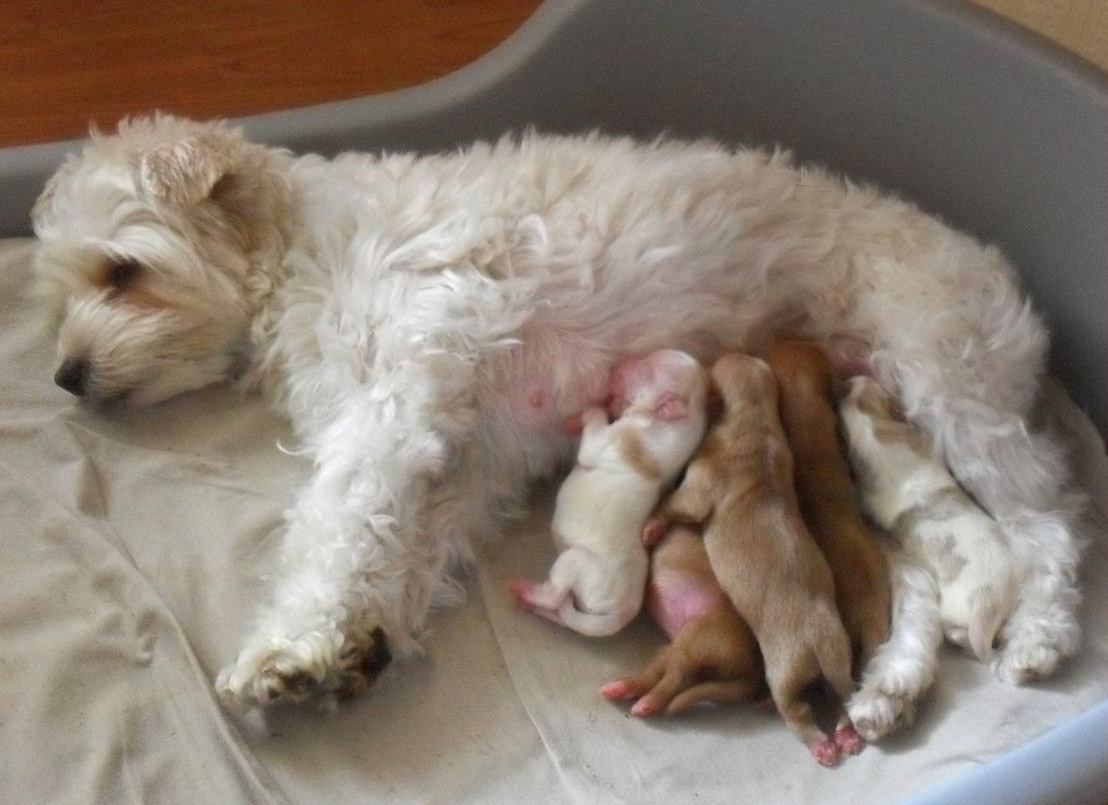 A female dog is nursing her newborn puppies. The female dog may produce colostrum 1–7 days before giving birth, lasting for around three months.[92][93] Colostrum peak production was around 3 weeks postpartum and increased with litter size.[93] The dog can sometimes vomit and refuse food during child contractions.[94] In the later stages of the dog's pregnancy, nesting behaviour may occur.[95] Puppies are born with a protective fetal membrane that the mother usually removes shortly after birth. Dogs can have the maternal instincts to start grooming their puppies, consume their puppies' feces, and protect their puppies, likely due to their hormonal state.[96][97] While male-parent dogs can show more disinterested behaviour toward their own puppies,[98] most can play with the young pups as they would with other dogs or humans.[99] A female dog may abandon or attack her puppies or her male partner dog if she is stressed or in pain.[100] Intelligence Main article: Dog intelligence Researchers have tested dogs' ability to perceive information, retain it as knowledge, and apply it to solve problems. Studies of two dogs suggest that dogs can learn by inference. A study with Rico, a Border Collie, showed that he knew the labels of over 200 different items. He inferred the names of novel things by exclusion learning and correctly retrieved those new items after four weeks of the initial exposure. A study of another Border Collie, Chaser, documented that he had learned the names and could associate them by verbal command with over 1,000 words.[101] One study of canine cognitive abilities found that dogs' capabilities are similar to those of horses, chimpanzees, or cats.[102] One study of 18 household dogs found that the dogs could not distinguish food bowls at specific locations without distinguishing cues; the study stated that this indicates a lack of spatial memory.[103] Dogs demonstrate a theory of mind by engaging in deception.[104] Another experimental study showed evidence that Australian dingos can outperform domestic dogs in non-social problem-solving, indicating that domestic dogs may have lost much of their original problem-solving abilities once they joined humans.[105] Another study showed that after undergoing training to solve a simple manipulation task, dogs faced with an unsolvable version of the same problem look at humans, while socialized wolves do not.[106] Communication Main article: Dog communication Dog communication is how dogs convey information to other dogs, understand messages from humans, and translate the information that dogs are transmitting.[107]: xii Communication behaviors of dogs include eye gaze, facial expression,[108][109] vocalization, body posture (including movements of bodies and limbs), and gustatory communication (scents, pheromones, and taste). Dogs' scent marks their territories by urinating on them, which is more likely when entering a new environment.[110][111] Both sexes of dogs may also urinate to communicate anxiety or frustration, submissiveness, or when in exciting or relaxing situations.[112] Aroused dogs can be a result of the dogs' higher cortisol levels.[113] Between 3 and 8 weeks of age, dogs tend to focus on other dogs for social interaction, and between 5 and 12 weeks of age, they shift their focus to people.[114] Belly exposure in dogs can be a defensive behavior that can lead to a bite or to seek comfort. Humans communicate with dogs by using vocalization, hand signals, and body posture. With their acute sense of hearing, dogs rely on the auditory aspect of communication for understanding and responding to various cues, including the distinctive barking patterns that convey different messages. A study using functional magnetic resonance imaging (fMRI) has shown that dogs respond to both vocal and nonvocal voices using the brain's region towards the temporal pole, similar to that of humans' brains. Most dogs also looked significantly longer at the face whose expression matched the valence of vocalization.[115][116][117] A study of caudate responses shows that dogs tend to respond more positively to social rewards than to food rewards.[118] |
振る舞い 主な記事 犬の行動 以下も参照のこと: 犬の行動§他のイヌ科動物と比較した行動 犬の行動とは、内的・外的刺激に対する家庭犬(個体または集団)の内的に調整された反応(行動または不作為)のことである[73]。犬の心は数千年にわた る人間との接触によって形成されてきた。彼らは人間を理解しコミュニケーションする能力を獲得しており、人間の行動に独特に同調する。行動科学者は、イヌ の近縁種や類人猿のような他の高度な知能を持つ哺乳類には備わっていない、家庭犬の一連の社会的認知能力は、子供の社会的認知能力と並行するものであると 考えた[75]。 生産に関連する形質で選択された他の家畜種とは異なり、イヌは当初その行動で選択された。2016年、ある研究はオオカミとイヌの間で11の固定遺伝子の みが変異を示したことを発見した[78]。これらの遺伝子の変異は自然進化の結果とは考えにくく、イヌの家畜化の際に形態と行動の両方で選択されたことを 示している。これらの遺伝子はカテコールアミン合成経路に影響を及ぼすことが示されており、遺伝子の大部分は闘争・逃走反応[77][79](すなわち、 77][80][77]犬における高い社交性と恐怖心の欠如の特徴には、問題解決能力を犠牲にして社交性を亢進させるヒトのウィリアムズ・ビューレン症候 群に関連する遺伝的修飾が含まれている可能性がある。 [2023年に58頭の犬を対象に行われた研究では、注意欠陥多動性障害に類似していると分類された犬の中には、セロトニンとドーパミンの濃度が低い犬も いた[82]。 [83]犬はトラウマや虐待、恐怖や不安、縄張りの保護、あるいは貴重な品物を守るために攻撃的になることがある。[84]犬に見られる心的外傷後ストレ ス障害(PTSD)による急性ストレス反応が慢性ストレスに発展することがある。[85]PTSDの警察犬はしばしば仕事を拒否することがある。 犬には捕食衝動と呼ばれる自然な本能があり(この言葉は主に訓練犬の習性を表すのに使われる)、これは繁殖によって影響を受けることがある。このような本 能は、対象物や他の動物を獲物と見なしたり、独占行動を駆り立てたりする。このような特性は、害獣やその他の害虫を狩ったり殺したりするために使われるよ うに、犬種によっては強化されている[87]。ある研究によると、オオカミの方がイヌよりも食物の隠し場所を見つける能力が高かったが、これはオオカミと イヌの「動機の違い」によるものであると考えられている[88]。ある研究では、この行動はオオカミから受け継いだものであり、巣穴における腸内寄生虫の 存在を減らすために進化した行動であろうという仮説が立てられている[89]。 ほとんどの犬は泳ぐことができる。412頭の犬を対象とした研究では、約36.5%の犬は泳げなかったが、残りの63.5%はプールでトレーナーなしで泳 ぐことができた[90]。55頭の犬を対象とした研究では、水泳と変形性股関節症の関節の改善との間に相関関係があることがわかった[91]。 授乳  生まれたばかりの子犬に授乳するメス犬。 メス犬は出産の1~7日前に初乳を分泌し、約3ヵ月間持続することがある[92][93]。初乳の分泌量のピークは産後3週間頃で、子犬の大きさとともに 増加する[93]。犬は子宮収縮中に嘔吐したり、食事を拒否したりすることがある[94]。犬の妊娠後期には、巣作り行動が起こることがある[95]。子 犬は保護用の胎膜を付けて生まれるが、通常、母犬は出生直後に胎膜を取り除く。犬はホルモンの状態によるものと思われるが、子犬の毛づくろいを始めたり、 子犬の糞を消費したり、子犬を保護したりする母性本能を持つことがある[96][97]。雄の親犬は自分の子犬に対してより無関心な行動を示すことがある が[98]、ほとんどは他の犬や人間と遊ぶように幼い子犬と遊ぶことができる[99]。雌の犬はストレスや苦痛を感じている場合、子犬や雄のパートナー犬 を見捨てたり攻撃したりすることがある[100]。 知能 主な記事 犬の知能 研究者たちは、情報を知覚し、知識として保持し、問題解決に応用する犬の能力をテストしてきた。2頭の犬の研究から、犬は推論によって学習できることが示 唆されている。ボーダーコリーのリコの研究では、彼は200以上の異なるアイテムのラベルを知っていた。彼は除外学習によって新しいものの名前を推測し、 最初の接触から4週間後にはそれらの新しいものを正しく取り出すことができた。別のボーダー・コリー、チェイサーの研究では、彼が名前を学習し、 1,000以上の単語と口頭命令で関連付けることができたことが記録されている[101]。 犬の認知能力に関するある研究では、犬の能力は馬、チンパンジー、または猫の能力に類似していることがわかった[102]。18頭の家庭犬を対象としたあ る研究では、犬は合図を区別することなく、特定の場所にあるフードボウルを区別することができなかった。 [104] 別の実験的研究では、オーストラリアン・ディンゴが非社会的問題解決において飼い犬を上回ることができるという証拠が示され、飼い犬が人間の仲間入りをし た途端に本来の問題解決能力の多くを失ってしまった可能性を示している[105]。別の研究では、単純な操作課題を解く訓練を受けた後、同じ問題の解けな いバージョンに直面した犬は人間を見るが、社会化されたオオカミは見ないことが示されている[106]。 コミュニケーション 主な記事 犬のコミュニケーション 犬のコミュニケーションとは、犬が他の犬に情報を伝えたり、人間からのメッセージを理解したり、犬が発信している情報を翻訳したりすることである [107]: xii 犬のコミュニケーション行動には、視線、表情、[108][109]発声、体の姿勢(体や手足の動きを含む)、味覚コミュニケーション(匂い、フェロモ ン、味覚)などがある。犬のにおいは、新しい環境に入ったときに起こりやすい排尿によって縄張りを示す。[110][111]また、犬の雌雄ともに、不安 や欲求不満、従順さを伝えるため、あるいは刺激的な状況やリラックスした状況のときに排尿することがある。[112]犬が興奮するのは、犬のコルチゾール レベルが高くなった結果である可能性がある。 [113]生後3週から8週の間、犬は社会的相互作用のために他の犬に注目する傾向があり、生後5週から12週の間、人に注目するようになる[114]。 人間は発声、手信号、体の姿勢などを用いて犬とコミュニケーションをとる。鋭い聴覚を持つ犬は、さまざまなメッセージを伝える特徴的な吠え声など、さまざ まな合図を理解し、それに反応するために、コミュニケーションの聴覚的側面に依存している。機能的磁気共鳴画像法(fMRI)を用いた研究で、犬は人間の 脳と同じように側頭極に向かう脳の領域を使って、発声と非発声の両方の声に反応することが示された。また、ほとんどの犬は、発声の価 値に一致する表情の顔を有意に長く見ていた[115][116][117]。尾状突起の反応の研究から、犬は食物報酬よりも社会的報酬にポジティブに反応 する傾向があることが示されている[118]。 |
| Ecology Population The dog is probably the most widely abundant large carnivoran living in the human environment.[119][120] In 2013, the estimated global dog population was between 700 million[121] and 987 million.[122] About 20% of dogs live as pets in developed countries.[123] In the developing world, it is estimated that three-quarters of the world's dog population lives in the developing world as feral, village, or community dogs.[124] Most of these dogs live as scavengers and have never been owned by humans, with one study showing that village dogs' most common response when approached by strangers is to run away (52%), or respond aggressively (11%).[125] Competitors and predators Feral and free-ranging dogs' potential to compete with other large carnivores is limited by their strong association with humans.[119] Although wolves are known to kill dogs, they tend to live in pairs in areas where they are highly persecuted, giving them a disadvantage when facing large dog groups.[126][127] In some instances, wolves have displayed an uncharacteristic fearlessness of humans and buildings when attacking dogs, to the extent that they have to be beaten off or killed.[128] Although the numbers of dogs killed each year are relatively low, it induces a fear of wolves entering villages and farmyards to take dogs, and losses of dogs to wolves have led to demands for more liberal wolf hunting regulations.[126] Coyotes and big cats have also been known to attack dogs. In particular, leopards are known to have a preference for dogs and have been recorded to kill and consume them, no matter their size.[129] Siberian tigers in the Amur River region have killed dogs in the middle of villages. Amur tigers will not tolerate wolves as competitors within their territories, and the tigers could be considering dogs in the same way.[130] Striped hyenas are known to kill dogs in their range.[131] Diet See also: Dog food 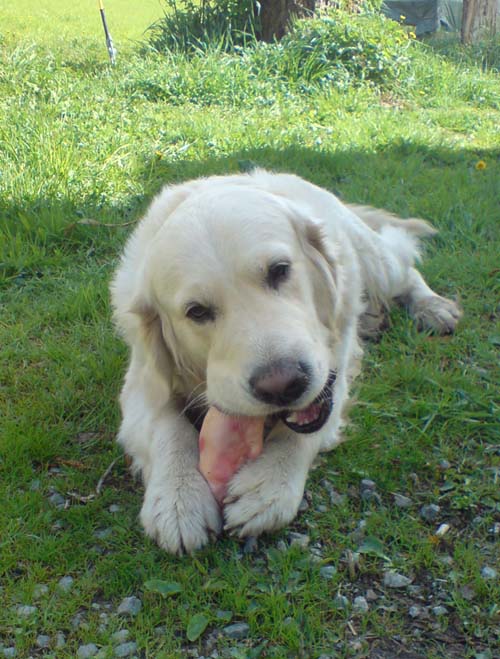 A Golden Retriever gnawing on a pig's foot Dogs have been described as omnivores.[5][132][133] Compared to wolves, dogs from agricultural societies have extra copies of amylase and other genes involved in starch digestion that contribute to an increased ability to thrive on a starch-rich diet.[4] Similar to humans, some dog breeds produce amylase in their saliva and are classified as having a high-starch diet.[134] However, more like cats and less like other omnivores, dogs can only produce bile acid with taurine, and they cannot produce vitamin D, which they obtain from animal flesh. Of the twenty-one amino acids common to all life forms (including selenocysteine), dogs cannot synthesize ten: arginine, histidine, isoleucine, leucine, lysine, methionine, phenylalanine, threonine, tryptophan, and valine.[135][136][137] Like cats, dogs require arginine to maintain nitrogen balance. These nutritional requirements place dogs halfway between carnivores and omnivores.[138] Range As a domesticated or semi-domesticated animal, the dog has notable exceptions of presence in: The Aboriginal Tasmanians, who were separated from Australia before the arrival of dingos on that continent The Andamanese peoples, who were isolated when rising sea levels covered the land bridge to Myanmar The Fuegians, who instead domesticated the Fuegian dog, an already extinct different canid species Individual Pacific islands whose maritime settlers did not bring dogs or where the dogs died out after original settlement, notably the Mariana Islands,[139] Palau[140] and most of the Caroline Islands with exceptions such as Fais Island and Nukuoro,[141] the Marshall Islands,[142] the Gilbert Islands,[142] New Caledonia,[143] Vanuatu,[143][144] Tonga,[144] Marquesas,[144] Mangaia in the Cook Islands, Rapa Iti in French Polynesia, Easter Island,[144] the Chatham Islands[145] and Pitcairn Island (settled by the Bounty mutineers, who killed off their dogs to escape discovery by passing ships).[146] Dogs were introduced to Antarctica as sled dogs. Starting practice in December 1993, dogs were later outlawed by the Protocol on Environmental Protection to the Antarctic Treaty international agreement due to the possible risk of spreading infections.[147] Dogs shall not be introduced onto land, ice shelves or sea ice. — Protocol on Environmental Protection to the Antarctic Treaty, signed in 1991 in Madrid, amended version of Annex II, Article 4 (number two) |
エコロジー 個体数 2013年、世界の犬の推定個体数は7億頭[121]から9億8,700万頭[122]であった。 [123]発展途上国では、世界の犬の個体数の4分の3が野良犬、村犬、または地域犬として暮らしていると推定されている[124]。これらの犬のほとん どはスカベンジャーとして暮らしており、人間に飼われたことがない。ある調査によれば、見知らぬ人に近づかれたときの村犬の最も一般的な反応は、逃げる (52%)か、攻撃的に反応する(11%)である[125]。 競争相手と捕食者 野良犬や放し飼いの犬が他の大型肉食獣と競争する可能性は、人間との強い結びつきによって制限されている[119]。オオカミは犬を殺すことが知られてい るが、オオカミは非常に迫害されている地域でペアで生活する傾向があり、大型犬の群れに直面すると不利になる。 [126][127]場合によっては、オオカミは犬を襲う際に人間や建物に対して無類の恐れを示し、殴り飛ばしたり殺さなければならないほどである [128]。毎年殺される犬の数は比較的少ないが、オオカミが村や農場に侵入して犬を奪うことへの恐怖を誘発し、オオカミによる犬の損失はオオカミ狩りの 規制をより自由にする要求につながっている[126]。 コヨーテや大型ネコ科動物も犬を襲うことが知られている。特にヒョウは犬を好むことで知られており、大きさに関係なく犬を殺して食べることが記録されてい る[129]。アムールトラはオオカミを縄張り内の競争相手として許容せず、トラも同じように犬を考えている可能性がある[130]。 食餌 以下も参照: ドッグフード  豚の足をかじるゴールデン・レトリバー 犬は雑食性であると言われている[5][132][133]。オオカミと比較して、農業社会の犬はデンプン消化に関与するアミラーゼやその他の遺伝子のコ ピーを余分に持っており、デンプンが豊富な食事で成長する能力を高めている。 [人間と同様に、犬種によっては唾液中にアミラーゼを産生し、高デンプン食に分類されるものもある[134]。しかし、より猫に近く、他の雑食動物にはあ まり似ていないが、犬はタウリンを含む胆汁酸しか産生できず、動物の肉から摂取するビタミンDを産生できない。すべての生命体に共通する21種類のアミノ 酸(セレノシステインを含む)のうち、犬はアルギニン、ヒスチジン、イソロイシン、ロイシン、リジン、メチオニン、フェニルアラニン、スレオニン、トリプ トファン、バリンの10種類を合成できない[135][136][137]。猫と同様、犬は窒素バランスを維持するためにアルギニンを必要とする。これら の栄養要求量は、犬を肉食動物と雑食動物の中間的な位置に置いている[138]。 行動範囲 家畜化または半家畜化された動物である犬は、例外的に以下の地域に生息している: オーストラリア大陸にディンゴが到着する前にオーストラリアから分離してきたアボリジニのタスマニア人。 海面上昇でミャンマーへの陸橋が覆われ、孤立したアンダマン民族 すでに絶滅したイヌ科の異種であるフエギ犬を家畜化したフエギ人 海洋入植者が犬を持ち込まなかったか、最初の入植後に犬が絶滅した太平洋の個々の島々、特にマリアナ諸島[139]、パラオ[140]、ファイズ島やヌク オロなどの例外を除いたカロリン諸島の大部分[141]、マーシャル諸島[142]、ギルバート諸島[142]、 [142]ニューカレドニア、[143]バヌアツ、[143][144]トンガ、[144]マルケサス諸島、[144]クック諸島のマンガイア、フランス 領ポリネシアのラパ・イティ、イースター島、[144]チャタム諸島[145]、ピトケアン島(バウンティ号の反乱軍が定住し、通りかかった船に発見され るのを逃れるために犬を殺した)。 [146] 犬はそり犬として南極に導入された。1993年12月に導入が開始されたが、感染症を蔓延させる危険性があるとして、後に南極条約の環境保護に関する国際協定議定書によって禁止された[147]。 犬は陸地、棚氷、海氷に持ち込んではならない。 - 1991年にマドリードで署名された「南極条約の環境保護に関する議定書」附属書II第4条(2番)の改正版 |
| Roles with humans Main article: Human–canine bond Domestic dogs inherited complex behaviors, such as bite inhibition, from their wolf ancestors, who would have been pack hunters with complex body language. These sophisticated forms of social cognition and communication may account for their trainability, playfulness and ability to fit into human households and social situations,[148] probably also for early human hunter-gatherers. Dogs perform many roles for people, such as hunting, herding, pulling loads, protection, assisting police and the military, companionship and aiding disabled individuals. This influence on human society has given them the nickname "man's best friend" in the Western world. In some cultures, however, dogs are also a source of meat.[149][150] Pets 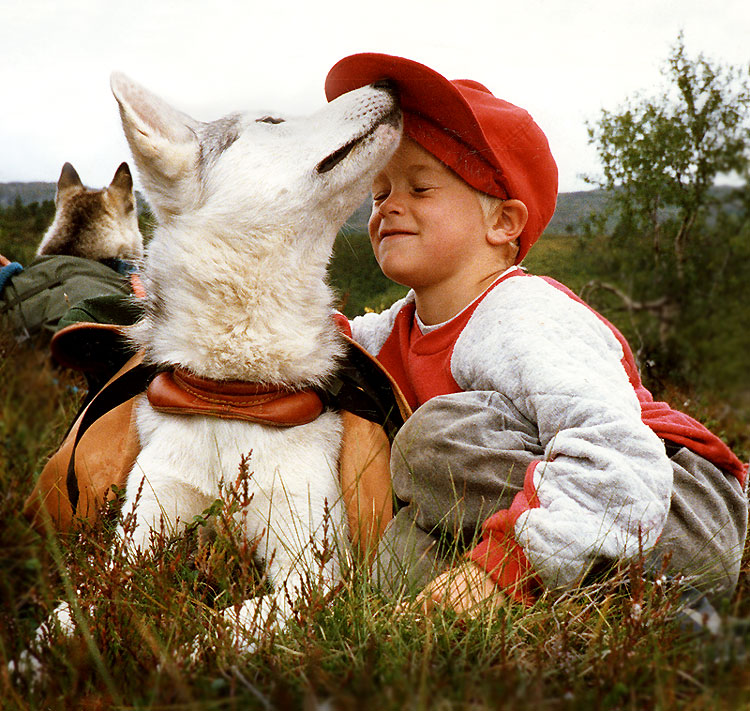 A Siberian Husky with a human as companionship The keeping of dogs as companions, particularly by elites, has a long history.[151] Pet dog populations grew significantly after World War II as suburbanization increased.[151] In the 1980s, there have been changes in the pet dog's role, such as the increased role of dogs in the emotional support of their human guardians.[152][page needed][153][page needed][154] Within the second half of the 20th century, the first dogs' social status major shift has been "commodification", shaping it to conform to social expectations of personality and behavior.[154] The second has been the broadening of the family's concept and the home to include dogs-as-dogs within everyday routines and practices.[154] A vast range of commodity forms aim to transform a pet dog into an ideal companion.[155] The list of goods and services available for dogs, such as dog training books, classes, and television programs, has increased.[156][155] The majority of contemporary dog owners describe their pet as part of the family, although some state that it is an ambivalent relationship.[154] Some dog trainers, such as on the television program Dog Whisperer, have promoted a dominance model of dog-human relationships. However, the idea of the "alpha dog" trying to be dominant is based on a controversial theory about wolf packs.[157][158] It has been disputed that "trying to achieve status" is characteristic of dog-human interactions.[159] Activities in which the dog is an integral partner, such as dog dancing and dog yoga, have increased in participation by human family members.[155] According to statistics published by the American Pet Products Manufacturers Association in the National Pet Owner Survey in 2009–2010, an estimated 77.5 million people in the United States have pet dogs.[160] The source shows that nearly 40% of American households own at least one dog, of which 67% own just one dog, 25% own two dogs, and nearly 9% own more than two dogs. The data also shows an equal number of male and female pet dogs, and less than one-fifth of the owned dogs come from shelters.[161] Workers In addition to dogs' role as companion animals, dogs have been bred for herding livestock (such as collies and sheepdogs); hunting; rodent control (such as terriers); search and rescue dogs;[162] detection dogs (such as those trained to detect illicit drugs or chemical weapons);[163][164] homeguard dogs; police dogs (K-9); welfare-purpose dogs; dogs who assist fishermen retrieve their nets; and dogs that pull loads (such as sled dogs).[5] In 1957, the dog Laika became one of the first animals to be launched into Earth orbit aboard the Soviets' Sputnik 2; she died during the flight from overheating.[165][166] Various kinds of service dogs and assistance dogs, including guide dogs, hearing dogs, mobility assistance dogs, and psychiatric service dogs, assist individuals with disabilities.[167][168] A study of 29 dogs reported that 9 dogs owned by people with epilepsy were reported to exhibit attention-getting behavior to their handler 30 seconds to 45 minutes prior to an impending seizure; there was no significant correlation between the patients' demographics, health, or attitude towards their pets.[169] Shows See also: Dog show There are breed-conformation shows or sports, including racing, sledding and agility competitions, for dogs to participate in with their guardians. In dog shows, also referred to as breed shows, a judge familiar with the specific dog breed evaluates individual purebred dogs for conformity with their established breed type as described in the breed standard.[170] Weight pulling, a dog sport involving pulling weight, has been criticized for promoting doping and for its risk of injury.[171] Food Main article: Dog meat Dog meat is consumed in some East Asian countries, including China,[149] Vietnam,[150] Korea,[172] Indonesia,[173] and the Philippines,[174] which date back to antiquity.[175] It is estimated that 30 million dogs are killed and consumed in Asia every year. Han Chinese traditionally ate dog meat.[176] China is the world's largest consumer of dogs, with an estimated 10 to 20 million dogs killed every year for human consumption, derived from extrapolating industry reports on meat tonnage.[177] Switzerland, Polynesia, and pre-Columbian Mexico also consumed dog meat in their histories.[178][179][180] In some parts of Poland[181][182] and Central Asia,[183][184] dog fat is reportedly believed to be beneficial for the lungs. Eating dog meat is a social taboo in most parts of the world; debates have ensued over banning the consumption of dog meat.[185] The Sui emperors attempted to outlaw dog meat consumption, with the Tang dynasty partially prohibiting dog meat consumption at events.[186] Proponents of eating dog meat have argued that placing a distinction between livestock and dogs is Western hypocrisy and that there is no difference in eating different animals' meat.[187][188][189][190] In some countries, saling or slaughtering dogs for human consumption is prohibited, though some still consume it in modern times. In Korea Main article: Dog meat consumption in South Korea The most popular Korean dog dish is called bosintang, a spicy stew meant to balance the body's heat during the summer months. Some followers of the custom claim this is done to ensure good health by balancing one's gi, or the body's 'vital energy'. Dogs are not as widely consumed as beef, pork and chicken.[191] The primary dog breed raised for meat in South Korea is the Nureongi, an unrecognized breed by international body.[192] In 2018, the South Korean government passed a bill for restaurants that sell dog meat to stop doing so during the year's Winter Olympics.[193] On 9 January 2024, the South Korean parliament passed a law banning the distribution and sale of dog meat, to take effect in three years.[194] Health risks Further information: Dog bite, Canine vector-borne disease, and Dog bite prevention In 2018, the World Health Organization (WHO) reported that 59,000 people died globally from rabies, with 59.6% in Asia and 36.4% in Africa. Rabies is a disease for which dogs are the most significant vector.[195] Dog bites affect tens of millions of people globally each year. Children in mid-to-late childhood are the largest percentage bitten by dogs, with a greater risk of injury to the head and neck. They are more likely to need medical treatment and have the highest death rate.[196] Sharp claws can lacerate flesh, which can lead to serious infections.[197] In the United States, cats and dogs are a factor in more than 86,000 falls each year.[198] It has been estimated that around 2% of dog-related injuries treated in U.K. hospitals are domestic accidents. The same study concluded that dog-associated road accidents involving injuries are more commonly involving two-wheeled vehicles.[199] Toxocara canis (dog roundworm) eggs in dog feces can cause toxocariasis. In the United States, about 10,000 cases of Toxocara infection are reported in humans each year, and almost 14% of the U.S. population is infected.[200] Untreated toxocariasis can cause retinal damage and decreased vision.[201] Dog feces can also contain hookworms that cause cutaneous larva migrans in humans.[202][203] Health benefits 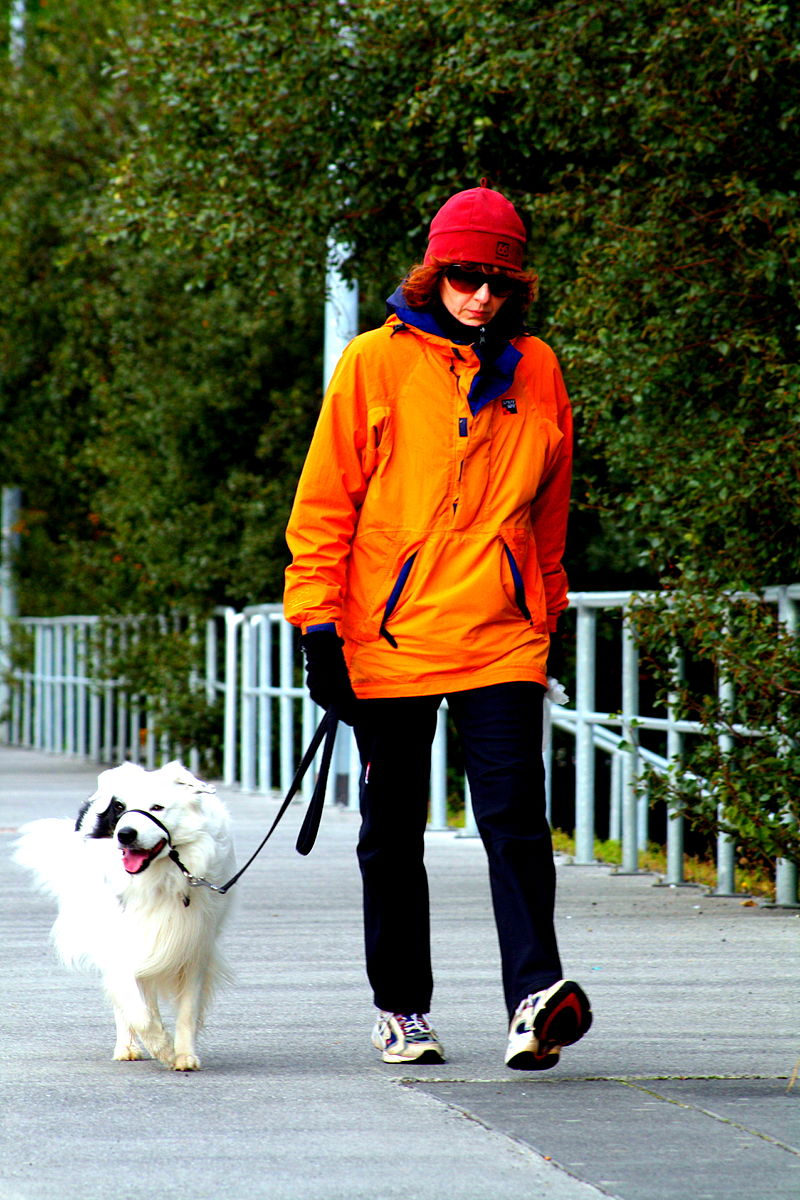 Walking a dog The scientific evidence is mixed as to whether a dog's companionship can enhance human physical and psychological well-being.[204] Studies suggest that there are benefits to physical health and psychological well-being, but they have been criticized for being 'poorly controlled'.[205][206] It states that "the health of elderly people is related to their health habits and social supports but not to their ownership of, or attachment to, a companion animal." Earlier studies have shown that pet dog or cat guardians make fewer hospital visits and are less likely to be on medication for heart problems and sleeping difficulties than non-guardians.[207] People with pet dogs took considerably more physical exercise than those with cats and those without pets; these effects are relatively long-term.[208] Pet guardianship has also been associated with increased coronary artery disease survival. Human guardians are significantly less likely to die within one year of an acute myocardial infarction than those who do not own dogs.[209] Studies have found a small to moderate correlation between dog ownership and increased adult physical activity levels.[210] A 2005 paper states, "recent research has failed to support earlier findings that pet ownership is associated with a reduced risk of cardiovascular disease, a reduced use of general practitioner services, or any psychological or physical benefits on health for community dwelling older people. Research has, however, pointed to significantly less absenteeism from school through sickness among children who live with pets."[204] In one study, new guardians reported a significant reduction in minor health problems during the first month following pet acquisition, which was sustained through the 10-month study.[208] The health benefits of dogs can result from contact with dogs in general, not solely from having dogs as pets. For example, when in a pet dog's presence, people show reductions in cardiovascular, behavioral, and psychological indicators of anxiety,[211] and are exposed to immune-stimulating microorganisms, which can protect against allergies and autoimmune diseases according to the hygiene hypothesis. Other benefits include dogs as social support.[212] One study indicated that wheelchair users experience more positive social interactions with strangers when accompanied by a dog than when they are not.[213] In 2015, a study found that pet owners were significantly more likely to get to know people in their neighborhood than non-pet owners.[214] Using dogs and other animals as a part of therapy dates back to the late 18th century, when animals were introduced into mental institutions to help socialize patients with mental disorders.[215] Animal-assisted intervention research has shown that animal-assisted therapy with a dog can increase smiling and laughing among people with Alzheimer's disease.[216] One study demonstrated that children with ADHD and conduct disorders who participated in an education program with dogs and other animals showed increased attendance, knowledge, and skill objectives and decreased antisocial and violent behavior compared with those not in an animal-assisted program.[217] Cultural importance Main articles: Cultural depictions of dogs and Dogs in religion Further information: List of fictional dogs 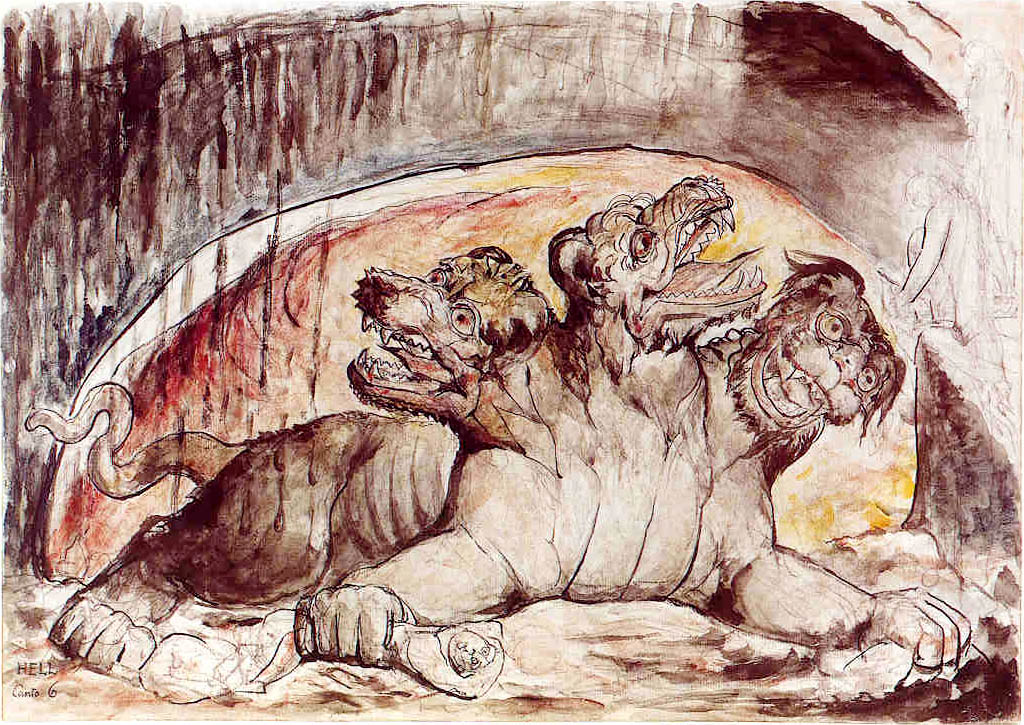 Cerberus, with the gluttons in Dante's third circle of hell, depicted by William Blake Dogs were depicted to symbolize guidance, protection, loyalty, fidelity, faithfulness, alertness, and love.[218] In ancient Mesopotamia, from the Old Babylonian period until the Neo-Babylonian period, dogs were the symbol of Ninisina, the goddess of healing and medicine,[219] and her worshippers frequently dedicated small models of seated dogs to her.[219] In the Neo-Assyrian and Neo-Babylonian periods, dogs were used as emblems of magical protection.[219] In China, Korea and Japan, dogs are viewed as kind protectors.[220] In mythology, dogs often serve as pets or as watchdogs.[220] Stories of dogs guarding the gates of the underworld recur throughout Indo-European mythologies[221][222] and may originate from Proto-Indo-European religion.[221][222] In Greek mythology, Cerberus is a three-headed, dragon-tailed watchdog who guards the gates of Hades.[220] Dogs are also associated with the Greek goddess Hecate.[223] In Norse mythology, a dog called Garmr guards Hel, a realm of the dead.[220] In Persian mythology, two four-eyed dogs guard the Chinvat Bridge.[220] In Welsh mythology, Annwn is guarded by Cŵn Annwn.[220] In Hindu mythology, Yama, the god of death, owns two watchdogs named Shyama and Sharvara who have four eyes. They are said to watch over the gates of Naraka.[224] A black dog is also considered to be the vahana (vehicle) of Bhairava (an incarnation of Shiva).[225] In Christianity, dogs represent faithfulness.[220] Within the Roman Catholic denomination specifically, the iconography of Saint Dominic includes a dog, after the saint's mother dreamt of a dog springing from her womb and becoming pregnant shortly after that.[226] As such, the Dominican Order (Ecclesiastical Latin: Domini canis) means "dog of the Lord" or "hound of the Lord" (Ecclesiastical Latin: Domini canis).[226] In Christian folklore, a church grim often takes the form of a black dog to guard Christian churches and their churchyards from sacrilege.[227] Jewish law does not prohibit keeping dogs and other pets. Jewish law requires Jews to feed dogs (and other animals that they own) before themselves and make arrangements for feeding them before obtaining them.[228][229] The view on dogs in Islam is mixed, with some schools of thought viewing them as unclean,[220] although Khaled Abou El Fadl states that this view is based on "pre-Islamic Arab mythology" and "a tradition to be falsely attributed to the Prophet."[230] The Sunni Maliki School jurists disagree with the idea that dogs are unclean.[231] |
人間との役割 主な記事 人間と犬の絆 家庭犬は、複雑なボディランゲージを持つ群れで狩りをするオオカミの祖先から、噛みつき抑制などの複雑な行動を受け継いだ。このような洗練された社会的認 知とコミュニケーションの形態は、犬が訓練されやすく、遊び好きで、人間の家庭や社会的状況に溶け込むことができる理由かもしれない[148]。 狩猟、牧畜、荷物の運搬、保護、警察や軍隊の補助、同伴、障害者の補助など、犬は人間のために多くの役割を果たしている。このような人間社会への影響か ら、欧米では「人間の親友」というニックネームがつけられている。しかし、一部の文化では、犬は食肉の供給源でもある[149][150]。 ペット  人間と一緒にいるシベリアンハスキー 特にエリートによるコンパニオンとしての犬の飼育には長い歴史がある[151]。 第二次世界大戦後、郊外化が進むにつれてペット犬の個体数は著しく増加した[151]。 1980年代には、保護者である人間の精神的なサポートとしての犬の役割が増加するなど、ペット犬の役割に変化が見られるようになった。 [152][ページが必要][153][ページが必要][154]20世紀後半において、最初の犬の社会的地位の大きな変化は「商品化」であり、性格や行 動に対する社会的な期待に適合するように形成された[154]。 2つ目は家族の概念と家庭の拡大であり、日常的なルーチンと慣習の中に犬としての犬を含めるようになった[154]。 ペットの犬を理想的なコンパニオンに変えることを目的とした膨大な商品形態[155]。 犬のしつけの本、教室、テレビ番組など、犬のために利用可能な商品やサービスのリストは増加している[156][155]。 現代の犬の飼い主の大多数は、ペットを家族の一員と表現しているが、アンビバレントな関係であると述べる者もいる[154]。 テレビ番組『ドッグ・ウィスパラー』のような一部のドッグ・トレーナーは、犬と人間の関係の支配モデルを推進してきた。しかし、「アルファ犬」が支配的で あろうとするという考え方は、オオカミの群れに関する論争の的となる理論に基づいている[157][158]。「地位を獲得しようとする」ことが犬と人間 の相互作用の特徴であるということには異論がある[159]。ドッグ・ダンスやドッグ・ヨガなど、犬が不可欠なパートナーである活動は、人間の家族の参加 も増加している[155]。 米国ペット用品製造業者協会が2009年から2010年にかけて発表した全米ペットオーナー調査の統計によれば、アメリカでは推定7750万人がペットの 犬を飼っている[160]。この資料によれば、アメリカの世帯の40%近くが少なくとも1匹の犬を飼っており、そのうち67%が1匹だけ、25%が2匹、 そして9%近くが2匹以上の犬を飼っている。また、オスとメスのペットの犬の数は同数であり、飼われている犬の5分の1以下は保護施設から来たものである ことが示されている[161]。 労働者 コンパニオンアニマルとしての犬の役割に加えて、犬は家畜の放牧(コリーや牧羊犬など)、狩猟、げっ歯類の駆除(テリアなど)、捜索救助犬、[162]探 知犬(違法薬物や化学兵器を探知するために訓練された犬など)、[163][164]ホームガード犬、警察犬(K-9)、福祉目的犬、漁師が網を回収する のを助ける犬、荷物を引く犬(そり犬など)のために飼育されてきた。 [5]1957年、犬ライカはソビエトのスプートニク2号で地球周回軌道に打ち上げられた最初の動物の一頭となったが、飛行中にオーバーヒートで死亡した [165][166]。 盲導犬、聴導犬、移動介助犬、精神科介助犬など、様々な種類の介助犬や補助犬が、障害を持つ人々を支援している[167][168]。 29頭の犬を対象とした研究によると、てんかん患者の飼っている9頭の犬は、発作が差し迫る30秒から45分前に、ハンドラーに対して注意を引く行動を示 したと報告されており、患者の属性、健康状態、ペットに対する態度の間には有意な相関関係は見られなかった[169]。 ショー 関連項目 ドッグショー レース、そり競技、アジリティ競技など、犬が保護者と一緒に参加する犬種適合のショーやスポーツがある。ドッグ・ショーはブリード・ショーとも呼ばれ、特 定の犬種に精通した審査員が、個々の純血種の犬が、犬種標準に記載された確立された犬種に適合しているかどうかを評価する[170]。ウェイト・プリング は、重量を引っ張るドッグ・スポーツであるが、ドーピングを助長し、怪我の危険性があるとして批判されている[171]。 食べ物 主な記事 犬肉 犬肉は中国、[149]ベトナム、[150]韓国、[172]インドネシア、[173]フィリピン[174]などの東アジアの国々で消費されており、その 歴史は古代にまでさかのぼる。漢民族は伝統的に犬肉を食していた[176]。中国は世界最大の犬の消費国であり、食肉トン数に関する業界報告から推定する と、毎年1,000万から2,000万頭の犬が人間の食用として殺されている[177]。 スイス、ポリネシア、先コロンブス期のメキシコも、その歴史の中で犬肉を食していた[178][179][180]。ポーランドの一部[181] [182]や中央アジアでは、犬の脂肪は肺に有益であると信じられていると報告されている[183][184]。 犬肉を食べることは世界のほとんどの地域で社会的タブーであり、犬肉の消費を禁止することについて議論が続いている[185]。 [186]犬肉を食べることの支持者は、家畜と犬を区別することは西洋の偽善であり、異なる動物の肉を食べることに違いはないと主張している[187] [188][189][190]。いくつかの国では、人間が食べるために犬を塩漬けにしたり屠殺したりすることは禁止されているが、現代でもそれを消費し ている国もある。 韓国では 主な記事 韓国における犬肉の消費 韓国で最もポピュラーな犬料理はボシンタンと呼ばれるもので、夏の間、体の熱のバランスをとるための辛い煮込み料理である。この習慣の信奉者の中には、 「気」、つまり体の「生命エネルギー」のバランスをとることで健康を確保するためだと主張する人もいる。犬は牛肉、豚肉、鶏肉ほど広く消費されていない [191]。 韓国で食肉用に飼育されている主な犬種は、国際機関によって未認可の犬種であるヌロンギである[192]。 2018年、韓国政府は犬肉を販売するレストランに対し、その年の冬季オリンピック期間中は犬肉を販売しないよう求める法案を可決した[193]。 2024年1月9日、韓国国会は犬肉の流通と販売を禁止する法律を可決し、3年後に施行する予定である[194]。 健康リスク さらに詳しい情報 犬の咬傷、犬媒介感染症、犬の咬傷予防 2018年、世界保健機関(WHO)は、狂犬病により世界で59,000人が死亡し、その59.6%がアジアで、36.4%がアフリカで死亡したと報告し た。狂犬病は、犬が最も重要な媒介となる疾患である[195]。犬に咬まれると、毎年、世界中で数千万人が罹患する。犬に咬まれる割合が最も高いのは小児 期の中・後期で、頭部や頸部を負傷するリスクが高い。鋭い爪は肉を裂傷し、重篤な感染症につながる可能性がある[197]。 米国では、犬猫は毎年86,000件以上の転倒の要因となっている[198]。英国の病院で治療される犬関連の負傷の約2%は家庭内事故であると推定され ている。同じ研究では、犬に関連した負傷を伴う交通事故は、二輪車によるものが多いと結論づけている[199]。 犬の糞便中のトキソカラ・カニス(犬回虫)の卵は、トキソカリ症の原因となる。米国では、毎年約10,000件のトキソカラ感染症がヒトで報告されてお り、米国人口のほぼ14%が感染している[200]。 トキソカリ症は未治療の場合、網膜の損傷や視力の低下を引き起こす可能性がある[201]。 犬の糞便には、ヒトに皮膚幼虫移行症を引き起こす鉤虫も含まれている可能性がある[202][203]。 健康上の利点  犬の散歩 犬の同伴が人間の身体的・心理的幸福を高めるかどうかについては、科学的根拠はまちまちである[204]。身体的健康や心理的幸福に利点があることを示唆 する研究はあるが、「コントロールが不十分」であるとして批判されている[205][206]。ペットの犬や猫の後見人は、非後見人に比べて通院回数が少 なく、心臓病や睡眠障害で投薬を受けている可能性が低いことが先行研究で示されている[207]。ペットの犬を飼っている人は、猫を飼っている人やペット を飼っていない人に比べて、かなり多くの運動をしている。人間の後見人は、犬を飼っていない人に比べて、急性心筋梗塞から1年以内に死亡する確率が有意に 低い[209]。研究の結果、犬の所有と成人の身体活動レベルの向上との間には、小から中程度の相関関係があることが判明している[210]。 2005年の論文によれば、「最近の研究では、ペットの所有が、心血管疾患のリスクの減少、一般開業医サービスの利用の減少、地域在住の高齢者の健康に対 する心理的または身体的な利点と関連するという以前の知見を支持することはできなかった。しかしながら、ペットと暮らしている子どもの病気による欠席が有 意に少ないという研究結果が指摘されている」[204]。ある研究では、新しい保護者は、ペットを飼い始めてから最初の1ヶ月間に軽度の健康上の問題が有 意に減少したと報告し、それは10ヶ月の研究を通して持続した[208]。 犬の健康上の利点は、ペットとして犬を飼うことのみからではなく、一般的に犬との接触から生じることもある。例えば、ペットの犬がいるとき、人は心臓血管 系、行動、不安の心理学的指標の減少を示し[211]、衛生仮説によれば、アレルギーや自己免疫疾患から身を守ることができる免疫刺激性微生物にさらされ る。212]ある研究では、車いす使用者は、犬を伴っていない場合よりも同伴している場合の方が、見知らぬ人とのより積極的な社会的交流を経験することが 示されている[213]。 セラピーの一環として犬やその他の動物を使用するようになったのは、18世紀後半にさかのぼる。 [216] ある研究では、犬や他の動物との教育プログラムに参加したADHDや行動障害の子どもたちは、動物介在プログラムに参加していない子どもたちと比較して、 出席率、知識、技能の目標が向上し、反社会的行動や暴力的行動が減少したことが実証されている[217]。 文化的重要性 主な記事 犬の文化的描写と宗教における犬 さらに詳しい情報 架空の犬のリスト  ウィリアム・ブレイクによって描かれた、ダンテの地獄の第三圏にいる貪食者たちとケルベロス。 犬は導き、保護、忠誠、忠実、警戒心、愛を象徴するものとして描かれた[218]。古バビロニア時代から新バビロニア時代までの古代メソポタミアでは、犬 は癒しと医療の女神であるニニシナの象徴であり[219]、彼女の崇拝者たちはしばしば座った犬の小さな模型を彼女に捧げた。 [219]新アッシリア時代と新バビロニア時代には、犬は魔法的な保護の象徴として用いられた[219]。 中国、韓国、日本では、犬は親切な保護者と見なされている[220]。 神話では、犬はしばしばペットとして、あるいは番犬として機能する[220]。冥界の門を守る犬の話は、インド・ヨーロッパ神話[221][222]の至 るところで繰り返されており、原インド・ヨーロッパ宗教に由来している可能性がある[221][222]。 ギリシャ神話では、ケルベロスはハーデスの門を守る3つの頭を持つ竜の尾を持つ番犬である。 [220]犬はギリシャ神話の女神ヘカテとも関連している[223]。北欧神話では、ガルムルと呼ばれる犬が死者の領域であるヘルを守っている [220]。ペルシャ神話では、2匹の4つの目を持つ犬がチンバト橋を守っている[220]。ウェールズ神話では、アンヌーンはクル・アンヌーンによって 守られている[220]。黒い犬はバイラヴァ(シヴァ神の化身)のヴァハナ(乗り物)とも考えられている[225]。 キリスト教では、犬は忠実さを表す[220]。特にローマ・カトリックの教派内では、聖ドミニコの図像には犬が描かれている。 [226]そのため、ドミニコ修道会(Ecclesiastical Latin: Domini canis)は「主の犬」または「主の猟犬」(Ecclesiastical Latin: Domini canis)を意味する[226]。 キリスト教の民間伝承では、教会の守護神はしばしば黒い犬の姿をしており、キリスト教の教会とその教会堂を冒涜から守っている[227]。ユダヤ教法では 犬やその他のペットを飼うことは禁止されていない。ユダヤ教法では、ユダヤ人は自分よりも先に犬(および所有する他の動物)に餌を与え、犬を入手する前に 餌を与える手配をすることが義務付けられている。 [228][229]イスラームにおける犬に対する見解はまちまちであり、犬を不浄とみなす学派もある[220]が、ハレド・アブー・エル・ファドルはこ の見解は「イスラーム以前のアラブの神話」と「預言者に誤って帰せられる伝承」に基づくものであると述べている[230]。スンニ派マリキ派の法学者は犬 が不浄であるという考えに反対している[231]。 |
| Dog – the species (or subspecies) as a whole, also any male member of the same.[232] Bitch – any female member of the species (or subspecies).[233] Puppy or pup – a young member of the species (or subspecies) under 12 months old.[234] Sire – the male parent of a litter.[234] Dam – the female parent of a litter.[234] Litter – all of the puppies resulting from a single whelping.[234] Whelping – the act of a bitch giving birth.[234] Whelps – puppies still dependent upon their dam.[234] |
犬-種(または亜種)全体、また同じ種の雄のメンバー[232]。 牝犬 - 種(または亜種)の雌のメンバー。 仔犬(puppy) - 生後12ヶ月未満の種(または亜種)の若い個体[234]。 サイアー(Sire) - 子のオスの親。 仔犬-仔犬の雌親[234]。 仔犬 - 1回の分娩によって生まれたすべての子犬[234]。 子宮娩出-雌犬が出産する行為[234]。 仔犬-まだ牝犬に依存している子犬[234]。 |
| Cat–dog relationship Cynanthropy Dognapping Domesticated silver fox Lists of dogs List of individual dogs List of oldest dogs |
猫と犬の関係 人間嫌い 犬の誘拐 飼いならされたシルバー・フォックス 犬のリスト 個々の犬のリスト 最長寿の犬のリスト |
| https://en.wikipedia.org/wiki/Dog |
|
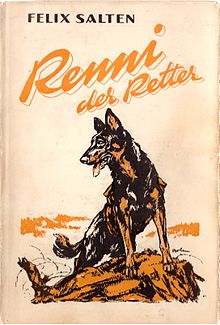 List of fictional dogs |
 |
リ ンク
文 献
そ の他の情報
Copyleft, CC, Mitzub'ixi Quq Chi'j, 1996-2099
☆
 ☆
☆